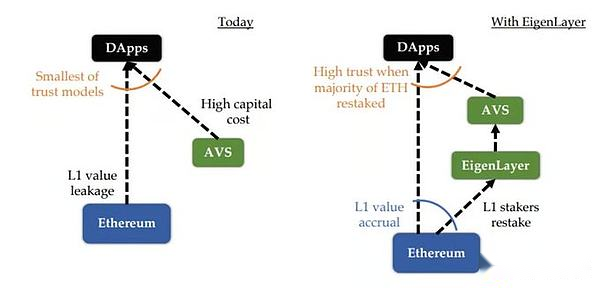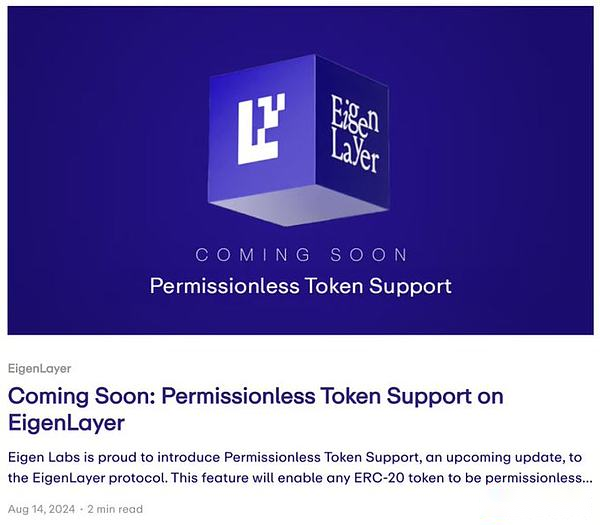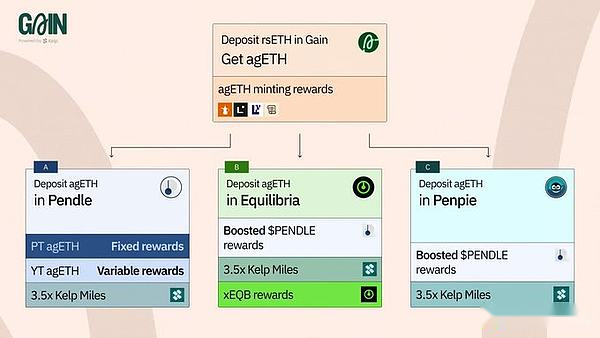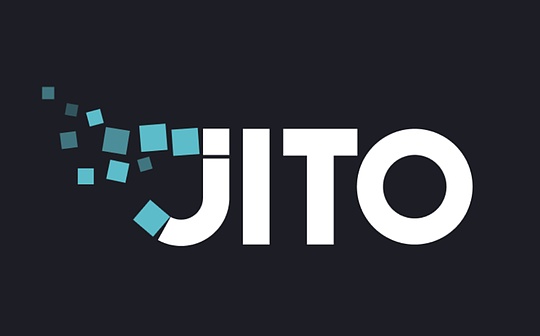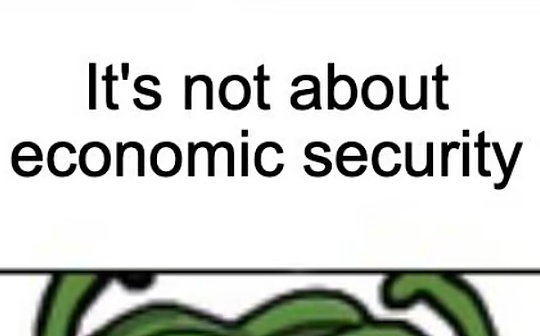
Author: Marco Manoppo, Primitive Ventures; Compilation: 0xxz@Bitchain Vision
Note: Dovey Wan, founder of Primitive Ventures, comments on this article: My thinking model for “re-pled”:Technically, it’s similar to the PoS version of merger mining; economically, it’s a clever way of on-chain rent-seeking; commercially, it’s a regular arbitrage game that effectively acts as a pre-ICO distribution of publishing projects.
Recently, I have been thinking about the future of re-staking because it is the main factor driving the market over the past 18 months.
For simplicity, I might quote EigenLayer or AVS when describing a broader concept of restaking in this article, but I use that term to summarize all restaking agreements and services built on it, not just specifically targeting EigenLayer.
The concept of EigenLayer and restaking opens Pandora’s box.
Conceptually, it is a good thing to expand the economic security of high liquidity and globally accessible assets.It allows developers to build on-chain applications without launching a completely new ecosystem for their project-specific tokens.
Source: EigenLayer’s Whitepaper
The premise is that ETH is a blue chip asset, which:
1. For Builder, it makes sense to use its economic security when building a product because it enhances security, reduces costs, and enables the product to focus on its core functionality.
2. Provide excellent product experience for end users
But 18 months after the release of the EigenLayer white paper, the pattern of re-pled has changed.
Now we have Bitcoin restake projects (e.g. Babylon), Solana restake projects (e.g. Solayer), and multi-asset restake projects (e.g. Karak and Symbiotic).Even EigenLayer has begun promoting license-free token support, allowing any ERC-20 token to be added as a re-staked asset without permission.
Source: EigenLayer’s Blog
The market has sent a signal that all tokens will be re-staked.
It’s no longer about expanding the economic security of ETH.The real key to re-staking is to issue a new type of on-chain derivatives → re-staking tokens (and the subsequent liquid re-staking tokens).
In addition, with the rise of liquid staking solutions, such as the Tally protocol,It is obvious that future restaking will cover all crypto tokens, not just L1 assets.We will see that stARB is re-staked as rstARB, and now rstARB is packaged as wrstARB again.
So, what does this mean for the future of cryptocurrencies?What happens when economic security can extend from any token?
Re-pled supply and demand dynamics
Two factors that decide to re-polize the future.
In the crypto world, two things are always correct:
1. People want more benefits
2. Developers want to create tokens
People want more benefits
From a supply side, the restaking agreement has the best PMF.
We learned from Wall Street’s forefathers that cryptocurrencies are rapidly becoming a degenerate market, constantly seeking greater risks.Give an example?The event news spin-off market is already on Polymarket.
The way restakers get more benefits is due to services built on top of restake agreements (AVS).Ideally, developers would choose to build on top of the restaking agreement and incentivize restakingers to allocate restaking assets to their projects.To do this, developers may share some of their revenue or provide rewards to republicators in the form of native tokens.
Let’s do some simple mathematical calculations.
Data as of September 7, 2024.
-
Currently, $10.5 billion worth of ETH is being re-staked on EigenLayer.
-
We assume that most of these restaking ETHs are LST.As a result, they have generated 4% annualized returns and they want to earn more from restaking.
-
To add an additional 1% APY per year, EigenLayer and its AVS need to create $105 million in value.This has not considered cuts and smart contract risks.
Obviously, restaking r/r is not worth it if it is just to increase 1% APY.I dare say itAt least doubled, about 8% or more, risk is worth it for capital allocators.This means that restaking ecosystems will need to create at least $420 million in value each year.
Source: KelpDAO
The huge gains we see from restaking are sponsored by the upcoming EIGEN token and the points program (example example) of the liquidity restaking agreement – by contrast, actual revenue returns (or expected revenue)negligible.
Now imagine a scenario like this: there are 3 re-staking agreements, 10 liquid re-staking agreements, and more than 50 AVS.Liquidity will be dispersed; developers (in this case consumers) will be burdened with the options they have, rather than being confident in the options they offer.Which restaking agreements should I be consistent with?What assets should I choose to enhance the economic security of my project?etc.
Therefore, either the amount of re-staked ETH needs to be increased significantly, or we need a money printing machine (also known as native token issuance) to run at full speed.
TLDR: In the staking protocol and its AVS, it will require a large amount of money to be invested in the form of tokens to maintain the vitality of the supplier.
Developers want to create tokens
On the demand side, the restaking agreement believes that it is cheaper and safer for developers to use restaking assets to support their applications rather than using their own application-specific tokens.
While this may be true for some applications that require a lot of trust and security, such as bridges, the reality is that the ability to issue your own tokens and use them as an incentive is the key to unlocking any crypto project, whether it is a chain or an application.
Using re-staking assets as a supplementary feature of the product can bring additional benefits, but it should not guide the product’s core value proposition and should not be designed in a way that cannibalizes your own token value.
Some, like Multicoin’s Kyle, have even taken a tougher stance and argued that economic security is not an important factor driving product growth.
To be honest, his point of view is hard to refute.
I’ve been in the cryptocurrency industry for 7 years and I’ve never heard any cryptocurrency high-level users who store most of their net assets on the chain tell me that he chose one product over another because itThe economic security behind it.
From an economic perspective, M^0’s Luca wrote an excellent article explaining that projects may even be cheaper to use their native tokens than ETH due to market inefficiency.
Wen token?Let’s face the reality that project-specific tokens with some form of governance function, practicality, economic or scarcity requirements are seen by investors as representatives of project success or reputation.Even without any remaining financial or control requirements, market sentiment is the same.In an industry as small as cryptocurrency, tokens are often more relevant to narrative or expected liquidity changes than cash flow.Regardless of how we look at it, it is obvious that the equity agency market is far from efficient in cryptocurrencies, and how the above-reasonable token prices translate into lower-reasonable project capital costs.Lower capital costs often come in the form of lower dilutions of venture capital rounds or higher valuations compared to other industries.It can be said that native tokens are actually lower than ETH for Builder due to inefficiency in the market across capital.
Source: Dirt Roads
To be fair, EigenLayer seems to have anticipated this because it designed a double resolution system.Now its competitors even use their marketing perspectives that support multi-asset re-staking as a differentiator.
If future restaking means that all tokens will be restaking, what is the real value of the restaking agreement to developers?
I think the answer is insurance and enhancement.
The future of multi-asset re-security: fragmentation of choice
If a project wants to improve its products and make itself unique, then restaking will become a complementary feature improvement for project integration.
-
Insurance: It provides additional guarantees because there is more capital to cover it, so the products offered can work as they are said in the advertisement.
-
Enhancement: The best strategic move for a restaking agreement is to reshape the entire narrative and convince Builder that the default mode should include some restaking technology elements in any product, as it will only make everything better.
-
Oh, you’re an oracle that is vulnerable to price manipulation attacks?What if we were AVS too?
-
Whether end users are concerned about this issue remains to be seen.
All tokens will compete as the preferred re-staking assets as this will give them perceived value and reduce selling pressure.AVS will have multiple types of re-staking assets to choose from, depending on their risk preferences, incentive rewards, specific features, and the ecosystem coordination they want to have.
This is no longer about core economic security, but insurance, rehypothecation and politics.
It is still clear that AVS will have many options as all tokens are restaked.
-
What assets should I use to ensure the economy is secure, what kind of political alliances do I want to build, and which ecosystem is best for my product?
Ultimately, this decision depends on what gives the best features for my product.Just as applications are deployed on multiple chains and eventually become application chains, AVS will eventually take advantage of the most benefited assets and ecosystems, and sometimes even use multiple of them.
This tweet from Jai perfectly outlines most Builders’ views on restaking proceeds.
We’ve seen projects like Nuffle struggle to solve this problem.
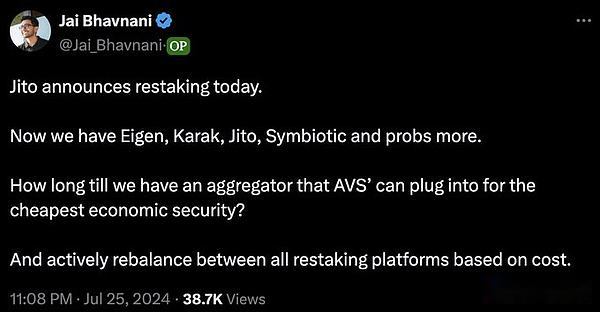
in conclusion
Crypto Twitter likes to think absolutely.The reality is that restaking would be an interesting basic concept that expands developers’ choices and impacts on-chain markets by issuing a new derivative, but this is not the second arrival of Jesus.
At least it can allow crypto asset holders with higher risk appetite to gain additional benefits, while expanding technology options and reducing developers’ engineering overhead.It provides complementary features for developers and creates a new derivatives market for on-chain asset owners.
Many assets will be re-staked, which gives developers a lot of choice before deciding which re-staked assets to integrate.Ultimately, developers will choose the re-staking asset ecosystem that will be the most beneficial to their products, and sometimes even multiple, just like when choosing to deploy a new chain.
Tokens use competition as re-staking assets because the new derivatives market for re-staking re-staking assets will benefit the tokens, giving them wider availability and perceived value.
This has never been related to economic security, but to insurance, rehypothecation and politics.


